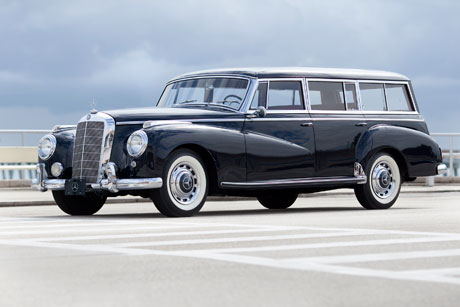SCM Analysis
Detailing
| Vehicle: | 1956 Mercedes-Benz 300C |
| Years Produced: | 1956 |
| Number Produced: | 1 |
| Original List Price: | $12,457 (300S cabriolet) |
| SCM Valuation: | $242,000 |
| Tune Up Cost: | $750 |
| Distributor Caps: | $75 |
| Chassis Number Location: | Tag on firewall, stamped on right front chassis rail |
| Engine Number Location: | Left side of block below head |
| Club Info: | Mercedes-Benz Club of America 1907 Lelaray St. Colorado Springs, CO 80909 |
| Website: | http://www.mbca.org |
| Investment Grade: | B |
This car sold for $242,000, including buyer’s premium, at Gooding & Company’s Amelia Island Auction, in Amelia Island, Florida, on March 12, 2010, against a pre-sale estimate of $200k-$300k.
Imagine yourself a wealthy Manhattanite in the ’50s, with a son in boarding school and gear to carry between multiple homes. A Bentley is already in the garage, so a distinctive wagon is just the ticket for a family hauler. The 300 sedan, just improved for 1956 in the “c” model, now featured M-B’s low-pivot swing axle rear suspension, and could be ordered with air conditioning. This advanced luxury car served as the basis for Mrs. Foulke’s wagon. The selection of luxurious wagons at the time was limited to the occasional coachbuilt Rolls shooting brake, so the choice seems obvious in retrospect.
Originally Graphite Gray, now Midnight Blue-both work
The popular but conservative Graphite Gray color was chosen, but with a broad red diagonal stripe on the door to personalize the car (not that one would have confused this unique car with another Mercedes). If the car had belonged to a Main Line resident, it probably would have borne a letter F in a circle on the tailgate, done in red to match the interior leather.
This very wagon went through Dearborn Automobile Company in the 1980s. At that time, it was in nice original condition, needing only cleaning and service work to be a near #2 quality collector car.
My appraisal price was the auction selling price
By 1997, it was in the collection of Charles Cawley of Wilmington, Delaware, and Camden, Maine. Mr. Cawley had it repainted in dark blue. The odometer read 44,172 miles. I appraised it at $60k at that time. A year later, the car changed hands at Barrett-Jackson’s Scottsdale auction, selling for $60k-right on my appraisal number. Having been around collector cars and auctions all my life, I can assure you it doesn’t always work out that way.
By 1999, the wagon was at Hatch & Sons of Hudson, Massachusetts, being restored for Palm Beach collector Lee Munder. I’m sure the car knew its way around the city.
It’s tempting to compare the various historical values of this car with those of the 300 and 300b/c four-door convertibles, themselves rare variants of the 300 sedan. A #2 quality 300c convertible might have traded for $60k in 1998, matching the ’98 auction price of this wagon.
Although improved by the 1999 Hatch restoration, the sale price of $242,000 at Gooding Amelia was 20% higher than I expected, and probably 20% higher than a similar quality 300c four-door convertible might have brought that day.
All the things the market wants
The present collector market seems to honor quality, rarity, and provenance, which this Mercedes has in abundance. To illustrate, today nice production cars like 280SLs lag behind the peak values of 1997, while the rarer (and more expensive) post-war M-Bs like the 1954 300S roadster have risen in value. I paid $165,000 in 2004 for the burgundy 300S roadster which sold at Gooding’s Scottsdale auction in January 2010 for, coincidentally, $242,000. The astonishing run-up of values of 300SLs since 1997 further illustrates this point.
Less expensive Mercedes models like 1951-54 220 cabriolets and 1958-60 220SE convertibles have also held value or increased slightly since 1997. I can only attribute this to the scarcity of good examples. Some later M-B models, such as the 220SEb/280SE/3.5 convertibles, have dropped maybe 15% in value since 1997. As lots of good examples of these cars are extant, this makes them not rare, so the drop in value fits my thesis.
As this wagon has quality, rarity, and provenance, I consider it a treasure well bought, and it probably made the seller a decent profit as well. A good deal for both sides, and happy news in any market.
